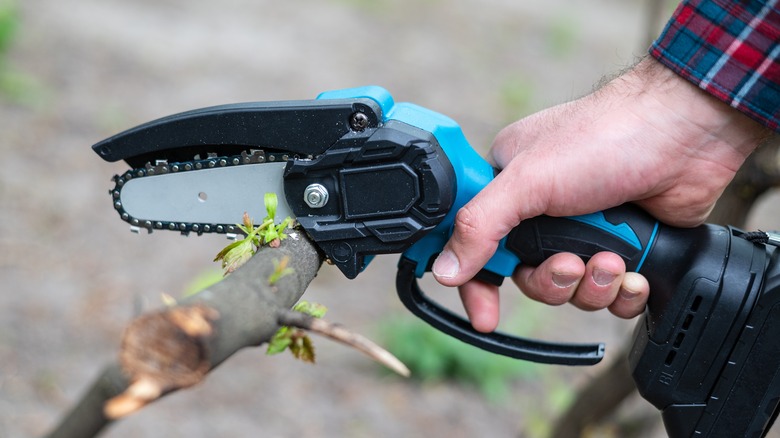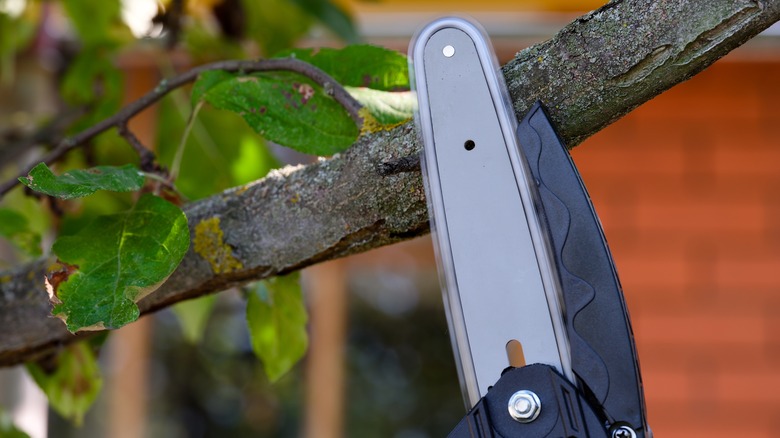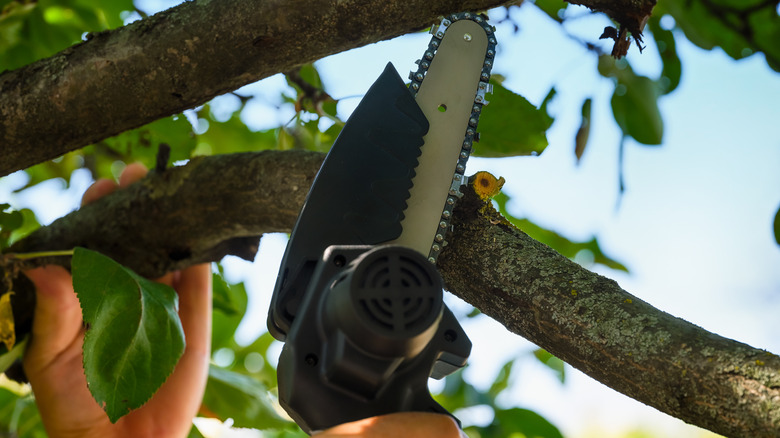The Correct Way To Prune Trees With A Mini Chainsaw
The mini chainsaw is a great outdoor power tool to have on hand. Because it runs on battery power, it's less messy to operate than a full-size model that may leak oil and fuel, and less power also means less potential for danger. However, that doesn't mean it's completely safe to operate. We tried pruning trees with a mini chainsaw, and it turned into a mess, complete with a cut to the skin and some blood. That being said, it's possible to safely and effectively prune trees on your property with a mini chainsaw It is, but you have to follow a few steps to avoid kickbacks and vibrations that can wear out your muscles.
First, though, you need to know how to use a mini chainsaw safely. Each model may have different safety features that you need to understand before operation. With the DeWalt 8-inch Mini Chainsaw ($139 at Ace Hardware), for example, you should always be standing on the ground when using it and you should never cut a branch that's over your shoulder height. Make sure both hands are gripping the tool in the proper locations to maintain full control. Additionally, you should always wear protective equipment, including eye and ear protection. Keep your work area free from debris that you could trip over, and never disable any safety features.
The best way to prune and shape trees with a mini chainsaw
When pruning your trees with a mini chainsaw, it's important to have a plan in place. Never take out more than 25% of the material at one time. If the tree is older and established, you should remove no more than 20%. However, that doesn't mean you should avoid pruning for fear of taking too much of the tree — proper pruning encourages new growth and helps maintain health. Cut the limb ¼ inch above any buds facing outward, which influences the direction of new growth. You also should cut the limb at a 45-degree angle, which prevents water damage and disease at the location of the cut.
When pruning dead branches, use the undercut method to prevent the weight of the branch from tearing the bark as it falls. Work from the bottom side of the dead branch several inches from the trunk, cutting about ⅓ of the way through. Then move another 1 or 2 inches away from the trunk and cut through the dead limb until it completely drops away. You then can safely cut the remaining dead branch closer to the trunk. With most of the branch's weight gone, you can remove the remaining stub cleanly.
How to avoid mistakes
Avoid making common mistakes when pruning trees with your mini chainsaw. Don't use a dull cutting tool, which can create rough cuts and damaging wounds from which the plant struggles to recover. With that in mind, always work with a sharpened chain. It's also important to make sure your chainsaw's battery is charged and have backup batteries on hand. Keep in mind how pruning different types of wood will affect battery performance, too. For example, softer wood will not drain the tool's power as quickly as harder wood. Softer woods often come from evergreens, while harder woods often come from deciduous trees.
When pruning trees, pay attention to the lubrication of the chain bar. Check and add oil regularly. If you're low on chain oil, the machine will not run properly and create rougher cuts. Without the proper level of oil, you're chain will get duller faster, decreasing its lifespan.


